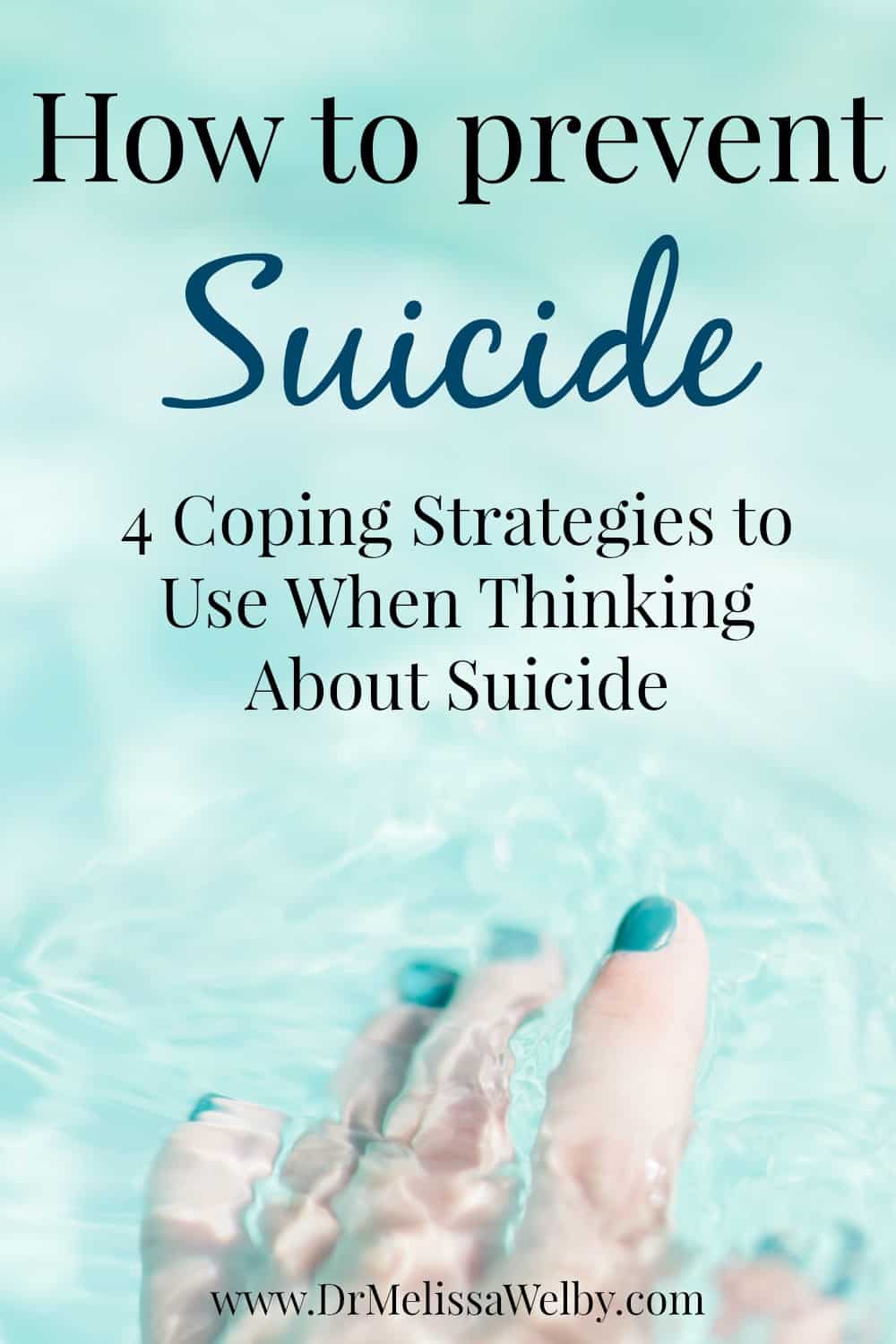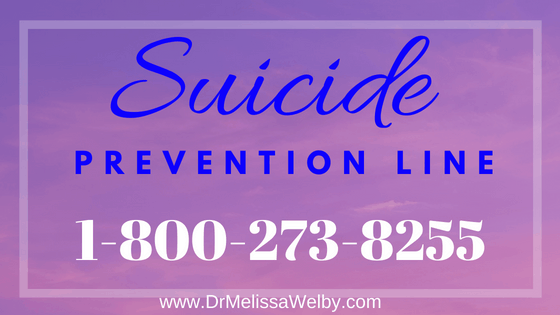Preventing suicide takes forethought and planning, not only in the world as a whole to create better support systems and treatment, but for individuals struggling with how to deal with suicidal thoughts. Creating a plan for how to prevent suicide and manage emotions at the height of intense feelings is a lot to ask of anyone. But coming up with a plan ahead of time for how to manage distress and suicidal urges can help allow the feelings to pass. This post includes coping strategies to manage distress, problem-solving techniques to help cut down on crisis, and suggestions on how to create coping cards and a hope box to use when thinking about suicide.
Suicide prevention hotline: 800-273-8255
Read more about my take on suicidal thoughts and preventing suicide here: A Psychiatrist’s Take on Suicidal Thoughts and Suicide Prevention
1. Prevent suicide by learning distress tolerance:
Suicidal impulses are often brief, intense urges lasting minutes to hours. Trying to come up with how to manage these waves of intense suicidal feelings the moment they are occurring is a challenge. Having a go-to list of coping strategies is a helpful tool in getting thru a wave of suicidal urges unharmed.
Even for people that are chronically suicidal, there are often moments of increased intensity for the suicidal feelings. Using these distress tolerance skills can help reduce risk.
How to prevent suicide: 10 Coping strategies to manage distress
Each individual may find different things soothing but I encourage you to come up with a variety of options so there are more to choose from at the moment you need them:
- Deep breathing: Use an app like Breathe2Relax or other mindfulness apps that can walk a person through a breathing relaxation exercise. Find one you like and have it ready on your phone.
- Phone apps such as Stress Free Now
- Aromatherapy: Pick a scent you like and carry it with you. I don’t believe aromatherapy cures all things like some claims out there but I do think it smells good! Taking a moment to focus on an enjoyable scent can be grounding.
- Exercise: I particularly like high-intensity bursts of exercise that can match the intensity of the emotion. Exhaust yourself by doing rapid jumping jacks, pushups, running quicker than is comfortable, burpees, a punching bag…there are many options available. If this level of exercise is not possible, find other exercises that are doable such as going for a walk.
- Take a warm bath
- Music: Crank it up or play it softly. Music can be a great distraction.
- Pet: There is nothing more grounding than spending some time petting or playing with your animal. Animals are always in the moment and can help us get back to the here-and-now by following their lead.
- Nature: Being out in nature is calming and grounding. It sometimes helps us to see the world is bigger than this moment.
- Do a word game or puzzle
- Any other distraction you can think of!
2. Using Coping Cards when thinking about suicide:
During a wave of intense distress and suicidal feelings, thoughts become distorted and people are often unable to come up with solutions at that moment.
The pattern of thinking during a crisis is often pretty consistent. Many people have predictable thoughts that happen when they feel distressed:
- “I’ll never get better”,
- “I’ll always feel this way”,
- “My life will never change”,
- “I’ve made no improvement”
It can be helpful to list these thoughts on a notecard and write out a matching response on the other side:
- “I’ve made it through times when I felt hopeless before”,
- “I do not always feel this way”
- “The last many times I felt this bad I was happy I didn’t harm myself the next day because I felt better”
Carry these card with you (or take a picture on your phone to access them) for the moments you may start to struggle and forget that distress and suicidal urges will pass.
3. Preventing suicide with a Hope Box:
A hope box is just like what it sounds: a box full of reminders of hope and reasons why you are choosing to live. Life-saving information is stored in this box so when a person is in crises and can’t recall their coping skills or reasons for living, they can access this box and see the information in one place.
I first heard about hope boxes while researching mental health apps and discovered Virtual Hope Box. This is a free app that adapts the physical hope box (which obviously would be challenging to carry around) into a virtual space so it is always there, ready to access on your phone. It includes options like: Distract me, Inspire me, Relax me, and Coping tools.
Things to include in the coping box:
- Coping cards that you made with alternative thoughts to counteract the challenging ones that usually come up in a crisis,
- Emergency numbers: both numbers for crises lines but also numbers for your support system (family, friends, therapists…whoever you need to call for help)
- Reminders of coping strategies to use and distress tolerance skills (see the list above for ideas of coping strategies)
- Lists of reasons to live
- Pictures of loved ones: family, friends, and pets,
- Letters from loved ones,
- Sentimental objects or gifts
- Reminders of past successes
- A pleasurable aromatherapy scent to distract you
- A treat you would enjoy like a piece of gum or a hard candy
Create both a virtual and a physical box. Going thru the physical box can be grounding in itself- physically touching the items and sorting through the box can serve as a distraction while waiting for the distress to pass.
4. Problem-solving skills:
Suicide is an attempt to solve a problem. Be it a harmful attempt, it is an attempt nonetheless. Although this may sound overly simplistic, improving problem-solving skills can help people see other options besides suicide.
The goal of these problem-solving techniques is not necessarily so that a person can solve everything in the heat of the moment. The hope is that improving problem-solving capabilities will cut down on moments of crisis by being proactively better able to think through challenges. Problem-solving techniques are one part of the formula to manage distress and suicidal ideation.
A lesson from the business world:
Problem-solving skills are commonly used in business to successfully resolve obstacles and are also needed in general life. Recommendations in business management rely upon breaking down the problem in order to better understand it and come up with a solution. These steps help take some of the emotions that can cloud thinking out of it.
5 Problem-solving steps to walk through:
- Define the problem.
- Determine the causes.
- Generate ideas.
- Select the best solution.
- Take action.
Get a therapist to help walk through problem-solving:
Many people are unable to do this problem-solving process on their own, especially when it comes to emotionally charged topics. These are great skills to practice with the help of a therapist who can walk through it with you.
The Suicide Prevention Resource Center discusses the evidenced-based treatment called Problem-Solving Therapy (PST):
In general, PST involves the following seven stages: (1) selecting and defining the problem, (2) establishing realistic and achievable goals for problem resolution, (3) generating alternative solutions, (4) implementing decision-making guidelines, (5) evaluation and choosing solutions, (6) implementing the preferred solutions, and (7) evaluating the outcome. A primary focus is learning and practicing PST skills, which are centered around empowering patients to learn to solve problems on their own.
How to deal with suicidal thoughts
I hope you have found these 4 ideas helpful. Take the time to get started making a list of distress tolerance coping strategies, writing out coping cards, and making your hope box. Do this ahead of time, when you are not feeling in crisis, to be better prepared with tools for management of suicidal urges and distress.
Are there other strategies that should be included in this post? Comment on what has helped you or a loved one so others can benefit.
Great book to read about how to deal with suicidal thoughts:
[amazon_textlink asin=’1572240563′ text=’Choosing to Live’ template=’ProductLink’ store=’drmelissawelb-20′ marketplace=’US’ link_id=’b04f0e7a-0772-4156-8f9e-c41c0abd772d’]
Here are other articles about suicidal thoughts, feelings, and prevention:
- Suicide Prevention Plan: 5 Tips to Deal With Thoughts of Suicide
- A Psychiatrist’s Take on Suicidal Thoughts and Suicide Prevention
- This is a link to all the articles I have written on recovery from depression full of tips for management and recovery.
- My resources page contains many useful links and my bookstore has recommended books about depression.
*These 2 books I recommended happen to be affiliate links but they are great books I would recommend to family. An affiliate link means the website gets a small commission on any sales at NO cost to you. Thank you for helping to support this website.**
Don't miss another post!

Subscribe to get our latest content by email.









Good thought. Next write to me how to motivate college students to concentrate their studies.
I am happy that you keep the conversation going about suicide and prevention. The more we all talk about suicide prevention, the more likely someone suffering in silence will reach out to someone. IMO. Thanks Melissa!
Great discussion on a much-needed topic!
Thank you Kevin. You are right, we must keep talking about this!
Someone I know and love just hit 8 years sober…during those years of addiction she attempted suicide multiple times. I’m so glad she made it through. Thank you for this great article! Talking about mental illness makes it less taboo.
Congratulations to your friend. Sounds like she did a lot of hard work to get through a very difficult time.